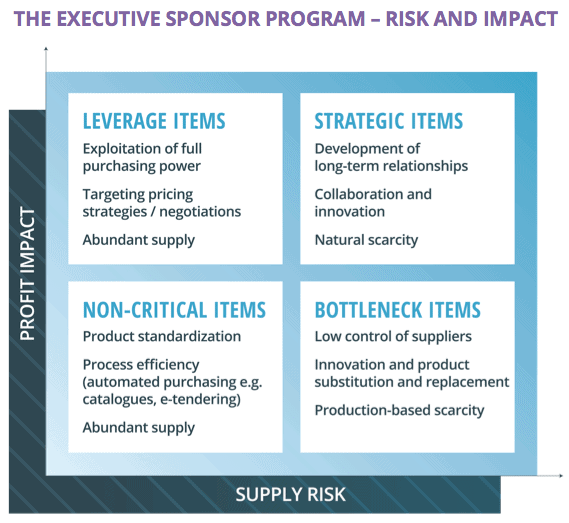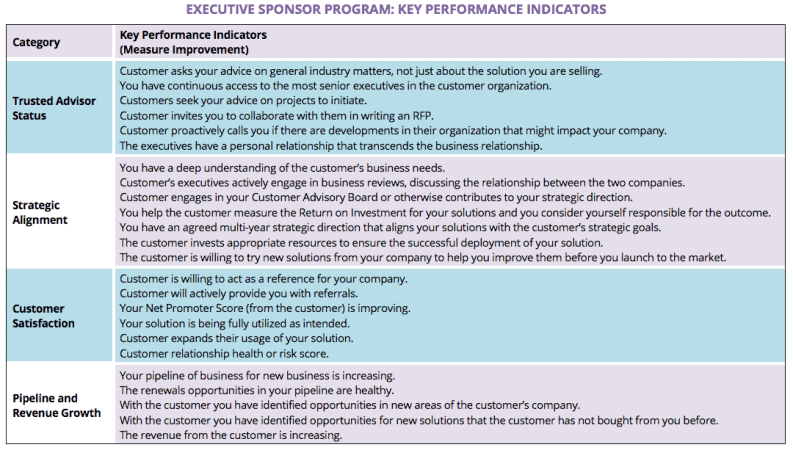In our original post. we outlined the 5 key questions to develop a relationship strategy; in this post, we outline how to use an executive sponsor program to create, measure, and communicate the value you bring to their organization.
Executive customer visits are often clumsy attempts to close a deal that the account manager has not been able to close on their own. These types of meetings often do more harm than good; the account manager is undermined, the executive is relegated to the position of salesperson (or sales manager), and the customers can rightly feel offended if the only time they get attention from the executive is when the executive is focused on selling them something.
We know that this is not the path to success and a better approach is to have a structured cadence of executive interaction – all mapped out through the five foundational elements of an effective Executive Sponsor Program:
- Program ownership
- Selecting the accounts
- Matching executive sponsors to accounts
- Role definition
- Measurement
1. Program ownership
The position of the Executive Sponsor Program owner varies across different organizations. Whether stemming from sales, marketing, customer success, or the executive office itself, these customers typically represent a disproportionately high percentage of the company’s total revenue and the relationships are likely to be strategic in nature. As a result, it’s key that the CEO play a strong role in defining the direction and oversight of the program’s design and execution, thereby communicating the strategic nature of the program to the rest of the organization.
2. Selecting the accounts
An Executive Sponsor Program should be reserved for the accounts that are most valuable – today and into the future – to your business. Strategic value, current revenue, account retention, and growth potential are factors that you should consider, but there’s also the customer’s perspective to take into account. How important are you to them? Then there’s exclusivity to consider; not every account can or should be included in your Executive Sponsor Program and you need to ask whether the Executive Sponsor Program can add value to a particular account.
Additionally, understanding the customer’s viewpoint will help inform the decision as to whether they should be in your Executive Sponsor Program, and whether they will be willing to participate. Buyers re-evaluate their supplier relationships continuously to assess the value they receive or their organization’s dependency on different vendors. Using something like the Kraljic Matrix (see below), your customer will place you in one of the quadrants in the matrix to reflect your profit (or revenue) impact on their business and the risk associated with discontinuity of supply.

If you’re placed in either the Strategic or Bottleneck quadrants, it is likely that the customer will want to be close to you and engage in your Executive Sponsor Program, if for no other reason than to limit their risk.
One final question that you should ask yourself before you put an account on the Executive Sponsor Program list: is the executive necessary to achieve the optimum value from the account? In a limited set of cases, your account managers will have achieved all or most of the critical measures of success on their own. If that’s the case you should reserve the executive for an account where the executive’s presence will make a material difference. This may well be part of your strategic go-to-market approach, based on your Ideal Customer Profile, and effective market/account segmentation.
3. Matching executive sponsors to accounts
Selecting the right executives to participate is a critical first step in executing a successful Executive Sponsor Program. Typically the executive should be at Vice President level or above. The most important requirement however when selecting and matching executives for the program is that there is a good fit between the executive and the executives in the account. Consider cultural compatibility, executive style, location, existing relationship, pertinent market expertise, domain knowledge, experience with similar customers, and any other common linkage between the customer executive and your executive.
The account manager should have the greatest insight into the needs of their account and thus has an important role to play in selecting the executive sponsor for their customers. The relationship between the account manager and their own executive will be a key success driver of the program in that particular account.
Each executive sponsor should have responsibility for no more than three accounts. Because each engagement requires significant time and effort, and the executive has a separate full-time role, it is unwise to expect the executive to be able to commit the time and resources to more than three executive sponsor engagements. Exceptions to this rule may occur where the executive is directly involved in sales as their primary function.
4. Role definition
The executive sponsor’s role is to position and represent the company to the customer. They should focus on the customer’s industry, market dynamics, business strategy, and how the customer’s strategy can be advanced with help from your company. They should take a holistic company perspective and not focus on a specific product or a service. The customer needs to not only believe in your solution, which is the account manager’s responsibility, but also in the company, which is part of the executive’s role. The executive must not take the place of the account manager but seek to build the currency and credibility of the account manager.
5. Measurement
The purpose of the Executive Sponsor Program is:
- To establish your company as a trusted advisor to the senior executives in the customer organization
- To achieve strategic alignment between the two companies as it pertains to the business problems that you solve
- To increase customer satisfaction
- To enable business growth for the customer through the broader application of your solutions.
This results in more sales opportunities and will ultimately increase your revenue.
The chart below provides a suggested list, by category, of the KPIs to measure and to assess the progress of an Executive Sponsor Program.

As mentioned previously, the revenue component is a lagging indicator. Revenue should be measured and you should definitely have revenue goals in the account plan – but the most impactful KPIs for the Executive Sponsor Program should focus on the other areas and you should be able to achieve performance improvement.




